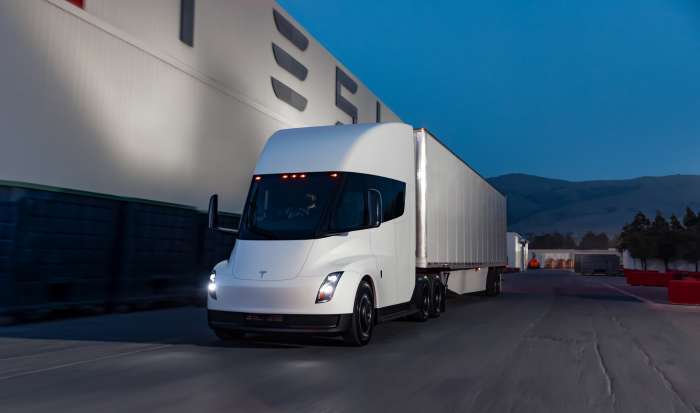The presentation and deliveries of the first units of the Tesla Semi have caused a rather big stir in the trucking industry, which for now is somehow skeptical of what this new electric truck is capable of. The delivery ceremony last Friday and the video that accompanied the event - in which the Semi was seen traveling 800 kilometers on a single charge - were not accompanied by key data that allows fleet managers to get an idea - however general - of its real competitiveness against diesel; though Elon Musk has come out to quite confirming the efficiency of the Semi.
Given the - logical - doubts that the presentation of the Semi has created in terms of its technical characteristics and the benefits it will actually offer, Elon Musk has taken a step forward confirming the efficiency of the Semi. The average consumption declared by Tesla is 1.7 kWh/mile (105.6 kWh/100 km), which would correspond to approximately a 900 kWh battery capacity; though this is important information, it is still not enough - especially for skeptics diesel-oriented - in order to know if the Semi is finally such a disruptive product for the transport industry.

This information is biased if three more fundamental pieces of data are not added to the equation: its transport capacity (that is, the weight it can transport while maintaining that efficiency), the power and recharging curve, and its final price, whether through purchase, rental or through another system that Tesla might make up in the future.
Beyond a groundbreaking design, the technology it has incorporated and its environmental sustainability, the transport industry is mostly governed by economic figures. The cost per kilometer, or the total cost of ownership (TCO) of the vehicle is the reality in a business field that needs the Tesla Semi to be able to transport the same load that a diesel truck now carries for less money.
Now, knowing the efficiency of the Semi (105.6 kWh/100 km or 1.7 kWh/100 km), operators can already begin to get an idea of what it means to use this electric truck as part of their fleet. By incorporating the cost of electricity into the operation, they will be able to calculate the savings that it entails in terms of fuel costs: this data also gives an idea of the Semi's battery capacity, which will be approximately 850-900 kWh, in fact necessary to travel 500 miles (804 km) at that rate of consumption, on a single charge.

What is necessary to know right now is how much cargo it is finally capable of transporting in order to meet that objective: a fully loaded truck of this type can weigh around 32 tons. Therefore the weight of the truck is essential information, in order to know how much to subtract from the weight of the trailer so that it can circulate on public roads. Tesla claims that the Semi will have about the same cargo capacity as a diesel truck, but these diesel truck actually operate in a wide range of weights.
Another piece of information that is unknown is the time the truck will need to remain stopped - that is, charging - to recover the full capacity of the battery to resume driving. Downtime is also key in the transportation industry. With the 1 MW chargers that have been announced by Tesla, and with a charging curve capable of maintaining this power level for most of the time it is connected, this operation should not take more than an hour, which is perfectly acceptable as per the trucking industry standards.

There is still another piece of information we need to know, that is also basic within this complex equation: the real price of the truck. Back in 2017, Tesla said that depending on the model, it could be purchased at $150,000, $180,000, and $200,000, depending on the model, though these amounts may have undergone myriad changes in recent times. If they are indeed true, the Semi would be a revolutionary truck since it could pay for itself in approximately three years with fuel economy alone.
In conclusion, it is necessary to have more information in order to know how the Tesla Semi will fit into the trucking industry and how it will take advantage that electric mobility offers as compared to diesel; it will take some time to see if it can compete with legacy trucks, but what is certain is that the market will be looking at this electric truck with interest and that Tesla has started a process that undoubtedly revolutionizes the industry.
All images courtesy of Tesla Inc.
Nico Caballero is the VP of Finance of Cogency Power, specializing in solar energy. He also holds a Diploma in Electric Cars from Delft University of Technology in the Netherlands, and enjoys doing research about Tesla and EV batteries. He can be reached at @NicoTorqueNews on Twitter. Nico covers Tesla and electric vehicle latest happenings at Torque News.












